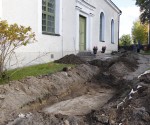 A thousand-year-old Viking rune stone whose whereabouts have been unknown for almost 200 years was rediscovered next to Hagby Church in Uppland, eight miles west of Uppsala in southeastern Sweden. It was discovered when workers dug a trench a few feet from the church to install a lightning conductor. Uppland Museum archaeologist Emelie Sunding was present to supervise the work in case anything of historical interest was found. When she saw the edge of a large, flat stone slab with some sort of engraving, she suspected it might be a rune stone. When the dig area was expanded and more of the stone exposed, her suspicion was confirmed.
A thousand-year-old Viking rune stone whose whereabouts have been unknown for almost 200 years was rediscovered next to Hagby Church in Uppland, eight miles west of Uppsala in southeastern Sweden. It was discovered when workers dug a trench a few feet from the church to install a lightning conductor. Uppland Museum archaeologist Emelie Sunding was present to supervise the work in case anything of historical interest was found. When she saw the edge of a large, flat stone slab with some sort of engraving, she suspected it might be a rune stone. When the dig area was expanded and more of the stone exposed, her suspicion was confirmed.
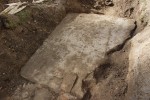 The rune stone is six feet long and more than four feet wide and is decorated with a snake-like creature with almond eyes. Its head and tail come together in the middle of the stone, and the body winds along both long edges, although one edge is broken. The head of a bird is carved opposite serpent. The runes are carved into the animal’s long body, so the missing piece makes the full inscription unreadable. The legible part reads: “Jarl and … stone after Gerfast, his father.” Rune stones were often dedications to deceased loved ones by surviving family members, so it’s likely the missing section includes the names of Jarl’s brothers and sisters.
The rune stone is six feet long and more than four feet wide and is decorated with a snake-like creature with almond eyes. Its head and tail come together in the middle of the stone, and the body winds along both long edges, although one edge is broken. The head of a bird is carved opposite serpent. The runes are carved into the animal’s long body, so the missing piece makes the full inscription unreadable. The legible part reads: “Jarl and … stone after Gerfast, his father.” Rune stones were often dedications to deceased loved ones by surviving family members, so it’s likely the missing section includes the names of Jarl’s brothers and sisters.
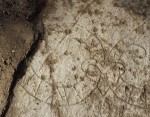 Although the stone is unsigned, the decorative style is recognizable as the work of a rune carver named Fot who was working in the mid-11th century. He worked in southern Uppland is believed to have carved more than 40 rune stones. Fot was known to be very particular about the stones he used and his runes are long and slender. Most of what we know of his work has survived only in replicas, so an original Fot is a very exciting find.
Although the stone is unsigned, the decorative style is recognizable as the work of a rune carver named Fot who was working in the mid-11th century. He worked in southern Uppland is believed to have carved more than 40 rune stones. Fot was known to be very particular about the stones he used and his runes are long and slender. Most of what we know of his work has survived only in replicas, so an original Fot is a very exciting find.
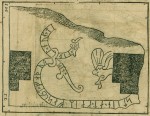 Uppland is rich with rune stone — more than 1,300 of the 2,700 known Viking rune stones in Sweden are located there — but most of them are fragmentary. Intact rune-decorated slabs are very rare. This one was known from a number of sources long after it was carved. It was first published, as many of its brethren were, in the 17th century. A woodcut of the stone made in the late 1600s by Johan Hadorph and Johan Leitz can be seen in the 1750 book on Swedish rune stones Bautil by Johan Göransson. It was the threshold stone of Hagby Church, installed at the door of the church portico in the 1400s.
Uppland is rich with rune stone — more than 1,300 of the 2,700 known Viking rune stones in Sweden are located there — but most of them are fragmentary. Intact rune-decorated slabs are very rare. This one was known from a number of sources long after it was carved. It was first published, as many of its brethren were, in the 17th century. A woodcut of the stone made in the late 1600s by Johan Hadorph and Johan Leitz can be seen in the 1750 book on Swedish rune stones Bautil by Johan Göransson. It was the threshold stone of Hagby Church, installed at the door of the church portico in the 1400s.
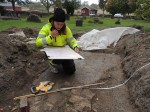 It last appears on the historical record in the early 19th century, but much of the original church was demolished in the 1830s and the stone went missing. There were stories of it having been pulled up and dumped into a nearby millstone. Thankfully those were just rumors. The stone wasn’t even moved; it was just covered with soil when the new church went up next to it and people forgot all about it.
It last appears on the historical record in the early 19th century, but much of the original church was demolished in the 1830s and the stone went missing. There were stories of it having been pulled up and dumped into a nearby millstone. Thankfully those were just rumors. The stone wasn’t even moved; it was just covered with soil when the new church went up next to it and people forgot all about it.
The stone will now be fully cleaned, studied and documented, including the back which, if we’re lucky, might have more carving that hasn’t been seen before because it has been embedded in the earth on its back since the late Middle Ages. Once conserved, the plan is for it to return to Hagby Church where it will be display in pride of place at long last.
Had this rune stone temporarily been (re-)used as part of a pathway, as the first picture (to/fro the building) and the last one (the additional material) might suggest ?
If so, I’ve seen similar practices at other cemeteries elsewhere, where the inscriptions where also still recognizable.
“the decorative style is recognizable as the work of a rune carver named Fot”: if we ever have another cat I might call it Fot. Craftsmen should be honoured.
I don’t think you could call a dog Fot. Just imagine shouting “Feet, Fot”. Absurd.
No doubt it was originally placed at the church entrance for everyone to walk on as a mark of disrespect to the former pagan lifestyle of the populace. Note, however, that maybe the majority of rhinestones in Uppland had a Christian theme, as their popularity peaked during the transition from paganism to Christianity.
Hi ruli!
I’m a colleague of Emelie’s and took part in unearthing the stone last week. We believe that the stone was in fact used as a threshold to the demolished medieval church. This is actually suggested in the 17th century sources and sketches we have of the stone.
Hi picturerock!
Although the runestone does not have a clear Christian theme, the large bird visible in the top part of the stone has been interpreted as a peacock. This bird has been linked to ideas of resurrection and may be construed as a piece of Christian iconography. Anne-Sofie Gräslund, a prominent scholar on early Christianity in Sweden, has written an article on the subject (link below, English summary on p.31)
http://sigtunamuseum.se/wp-content/uploads/2015/03/Situne-dei-2014_Graeslund.pdf